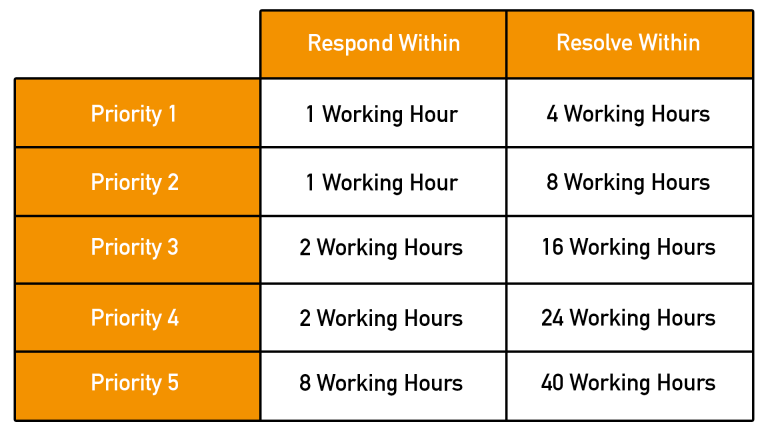Thank You For Requesting Support.

Our SLA's
Service Level Agreements (SLAs) essentially represent our promise to deal with your ICT issues and requests within a given time frame.
They show that we have an efficient and mature process for providing IT support and that you can have confidence in us.
The Basics
Our SLAs depend on the agreed hours cover and the priority of your issue or request.
Standard Hours of Cover
- While many clients have extended and out-of-hours of support, our standard cover runs from 7:00 am to 6:30 pm (GMT/BST), from Monday to Friday, but excluding public holidays for England.
- Our SLA timers run only during your agreed hours of cover.
- We provide on call engineer cover outside agreed hours of cover. Support from on call engineers is not subject to SLA’s and remedial work is chargeable.
How we work out priorities
Our SLA timers also depend on the priority of your issue or request. When you raise a ticket with us, we make an assessment based on the information you have given us.
We let you know the priority we have assigned, but are happy to take extenuating circumstances into account, if you think we’ve got it wrong.
Priority is based on two factors: urgency and impact.
Urgency
Roughly, this is how many people are affected by the incident, e.g.
LOW – one person or small group of people affected
- MEDIUM – department or large group of people affected
- HIGH – whole organisation is affected
Impact
Again, roughly speaking, this relates to how disruptive the incident is, e.g.
- LOW – there’s an easy and effective workaround, so this is more an irritation than a stoppage
- MEDIUM – operational efficiency is degraded, but there is either a reasonable workaround or other members of the team are unimpeded
- HIGH – the issue is critical and one or more major business processes are stopped
We then apply our priority matrix as follows:

In our experience most issues fall in to a Priority 4, so that tends to be a default. The priority assigned dictates the amount of time we give ourselves to deal with your incident or request.
The priority we assign will be referenced on the ticket but are happy to change the priority if you feel the issue needs more urgent attention.
We will also let you know who the contact is for your ticket, so you know exactly who is dealing with your request. If your ticket is escalated to another member of staff, you will be notified of this as well.
The clock is ticking
We have various clocks (timers) running on every ticket you raise, though most of our clients are only interested in two of them (“respond within” and “resolve within”).
These timers represent maximums – we generally come well within these time limits.
In certain circumstances we will put a clock on hold – for example when we are awaiting a response from you with further information or an approval for work that may have a temporary impact on you or your business.
“Respond within…”
This is the maximum amount of time (within your hours of cover) that it should take us to get back to you, and confirm who is dealing with your ticket – you get to speak to a trained technical expert straight away, rather than a recorded menu system or a call-logger.
“Resolve within…”
This is the one that everyone is really interested in: the maximum time it should take to get everything up and running.

Some examples of priorities
- Priority 1 – nobody can send or receive emails (everyone is affected, and a major business process is stopped)
- Priority 2 – Internet access for the whole company seems slower than usual (everyone is affected, and efficiency is degraded)
- Priority 3 – After the web browser has been upgraded for the company some of the shortcuts have disappeared (everyone is affected but there is an easy workaround)
- Priority 4 – Your computer is slow starting up in the morning, but everybody else is fine (your efficiency is lower but you’re the only person affected)
- Priority 5 – Someone is missing the shortcut everyone has to a shared folder, though they can save files to it by manually navigating to the folder (there’s a straightforward workaround, and only one person is affected)
Other exceptions to our priorities
The following are exceptions to our priorities and timers in the above matrix:
- Paid workshop repairs – very often we’re dependent on supply of parts or arrangements with you for collections and returns, so we usually allocate a priority of 5 for these jobs.
- Quotes – we have no timers on these requests, but we do our best to be prompt and keep you fully up to date.
- Low priority admin requests – these have response times that match priority 4 but a resolve time of a priority 5. Generally, we get plenty of advance notice and these requests are not urgent.
